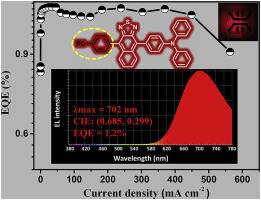Dyes and Pigments ( IF 4.1 ) Pub Date : 2017-10-21 , DOI: 10.1016/j.dyepig.2017.10.033 Xiaohui Tang , Xiang-Long Li , Haichao Liu , Yu Gao , Yue Shen , Shitong Zhang , Ping Lu , Bing Yang , Shi-Jian Su , Yuguang Ma

|
Herein, a new near-infrared (NIR) material, 4-(9-(4-(diphenylamino)phenyl)naphtho[2,3-c][1,2,5]thiadiazol-4-yl)benzonitrile (TPA-NZC), was designed and synthesized with the incorporation of an ancillary acceptor (cyanophenyl) into the donor-acceptor (D-A) molecular backbone of a red emitter TPA-NZP (4,9-diphenylnaphtho[2,3-c][1,2,5]thiadiazole). Compared with TPA-NZP, TPA-NZC exhibits an NIR emission (λmax = 710 nm) with a large redshift, as well as a maintained photoluminescence efficiency (ηPL) of 17% in film. Moreover, the non-doped OLED based on TPA-NZC emitter exhibits an excellent NIR emission at 702 nm with a maximum EQE of 1.2%, while the doped device achieves a deep-red emission at 656 nm with a maximum EQE of 3.2%. This work further verifies the reliability of “hot exciton” and hybridized local and charge-transfer state (HLCT) mechanism, as well as provides a strategy to design a narrow bandgap light-emitting material by introducing cyanophenyl as an ancillary acceptor in D-A systems.
中文翻译:

基于供体-受体分子结构的高效近红外发射:氰基苯基的辅助受体的作用
在这里,一种新的近红外(NIR)材料,4-(9-(4-(二苯氨基)苯基)萘[2,3- c ] [1,2,5]噻二唑-4-基)苄腈(TPA- NZC)的设计和合成方法是,将辅助受体(氰基苯基)掺入红色发射剂TPA-NZP(4,9-二苯基萘[2,3- c ] [1, 2,5]噻二唑)。用TPA-NZP相比,TPA-NZC表现出NIR发射(λ最大 = 710纳米)具有大的红移,以及一个保持光致发光效率(η PL),占电影的17%。此外,基于TPA-NZC发射器的非掺杂OLED在702 nm处具有出色的NIR发射,最大EQE为1.2%,而掺杂器件在656 nm处实现了深红色发射,最大EQE为3.2%。这项工作进一步验证了“热激子”以及混合的局部和电荷转移状态(HLCT)机制的可靠性,并提供了一种通过在DA系统中引入氰基苯基作为辅助受体来设计窄带隙发光材料的策略。











































 京公网安备 11010802027423号
京公网安备 11010802027423号